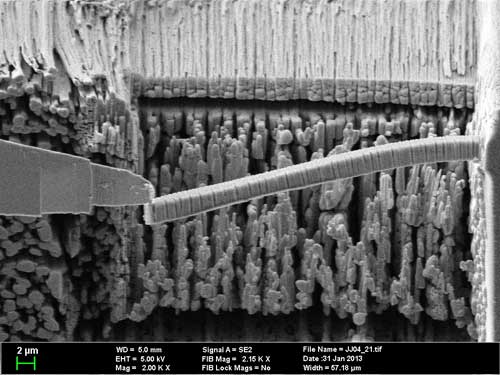| Posted: Nov 29, 2017 |
Nanostructure of the sea urchin spines inspires better cement
(Nanowerk News) The sea urchin spines are mostly made of calcite, usually a very brittle and fragile material. In the case of the sea urchin, however, the spines are much more durable than the raw material alone. The reason for its strength is the way that nature optimises materials using a brick wall-style architecture.
|
|
The research team Physical Chemistry, headed by Professor Helmut Cölfen, successfully synthesised cement at the nano-level according to this “brick and mortar principle”. During this process, macro-molecules were identified that take on the function of mortar, affixing the crystalline blocks to each other on the nano-scale, with the blocks assembling themselves in an ordered manner. The aim is to make cement more durable.
|
|
The study’s results are published in the 1 December 2017 issue of Science Advances ("Mesocrystalline calcium silicate hydrate: A bioinspired route toward elastic concrete materials").
|
 |
| Bending experiment on elastic cement in a scanning electron microscope, enlarged 2,000 times Bar-shaped micro-structure precision-cut from nano-structured cement using an ion beam, bends under the pressure of a micro-manipulator without breaking (micro-manipulator left in the picture). (Image: Dr Zhaklina Burkhard)
|
|
“Our cement, which is significantly more fracture-resistant than anything that has been developed thus far, provides us with completely new construction possibilities”, Cölfen adds. A pillar made of this cement could be built 8,000 metres high, or ten times as high as the current tallest building in the world, before the material at its base would be destroyed by its weight. Normal steel, which has a value of 250 megapascals, could only reach 3,000 metres in height.
|
|
In nanoscience, brick wall-style architecture can be compared to the work of a mason: each layer of brick that is laid is held in place by mortar. The guiding principle is to layer hard, then soft, hard, then soft materials. This is exactly the principle nature uses to make sea urchin spines so resilient. When force is applied to the brittle calcite, its crystalline block does crack, however, the energy is then transferred to a soft disordered layer. Since this material has no cleavage planes to tear, it prevents further cracking. A thin section of sea urchin spine reveals this structural principle: crystalline blocks in an orderly structure are surrounded by a softer amorphous area. In the sea urchin’s case, this material is calcium carbonate.
|
|
Mussel shells or bones are constructed in much the same way. “Our goal is to learn from nature", says Helmut Cölfen. The researcher has been honoured numerous times for his trailblazing results in the field of crystallisation, with, for example, the 2013 Academy Prize from the Berlin-Brandenburg Academy of Sciences and Humanities. Bionics or biomimetics is the term used for employing natural phenomena to inspire technical developments.
|
|
Cement itself has a disordered structure - each component sticks to all the others. This means: in order for cement to truly profit from the increased stability provided by brick and mortar construction, its structure will have to be reorganised at the nano-level. Helmut Cölfen describes the process as “encoding fracture-resistance at the nano-level”. In this case, it means identifying a material that bonds only with cement nanoparticles and nothing else in the cement. About ten negatively charged peptide combinations were identified that both adhere to and bond materials well.
|
|
In collaboration with the University of Stuttgart, the team was able to use an ion beam under an electron microscope to cut a bar-shaped micro-structure out of the nanostructured cement that was three micrometers in size. This micro-structure was then bent using a micro-manipulator. As soon as it was released, the micro-structure returned to its original position. Mechanical values could be calculated based on the elastic deformation of the micro-structure.
|
|
Based on these calculations, the optimised cement achieved a value of 200 megapascals. By comparison: Mussel shells, which are the gold standard in fracture-resistance, reach a value of 210 megapascals, which is only slightly higher. The concrete commonly used today has a value of two to five megapascals.
|
|
See urchin spines and mussel shells are made of calcite, because large quantities of calcium are available in water. Helmut Cölfen explains: “People have much better construction materials than calcite. If we succeed in designing the structures of materials and reproduce nature’s blueprints, we will also be able to produce much more fracture-resistant materials - high-performance materials inspired by nature”.
|

